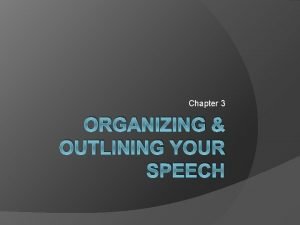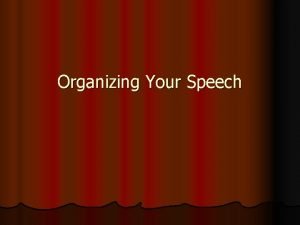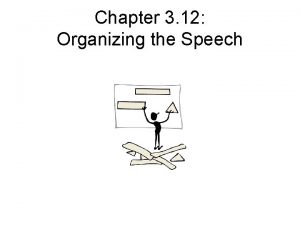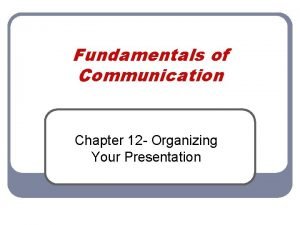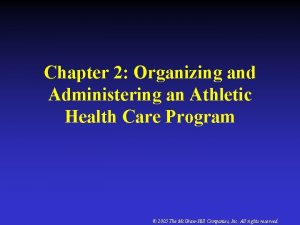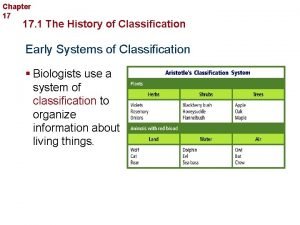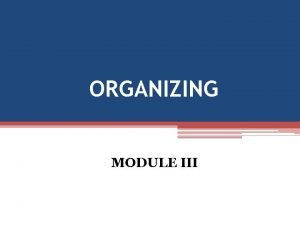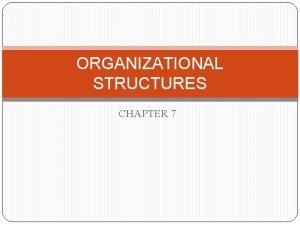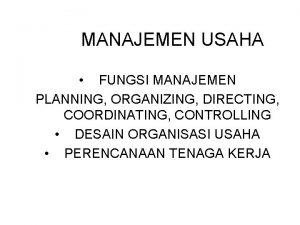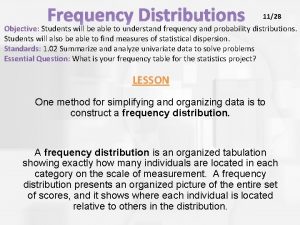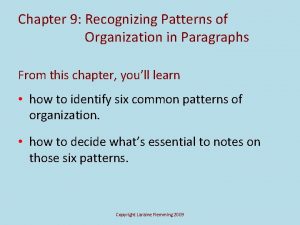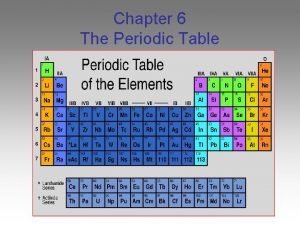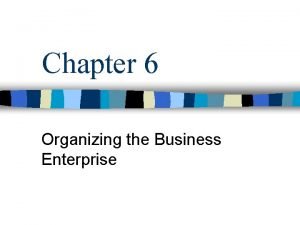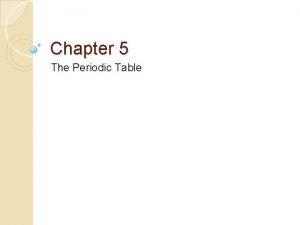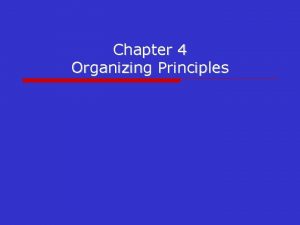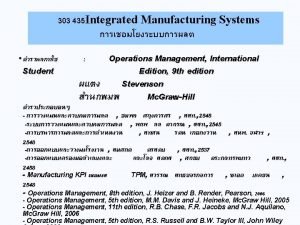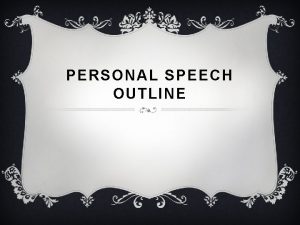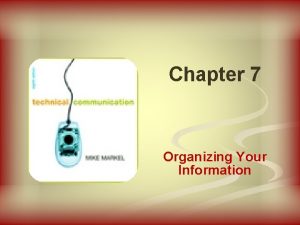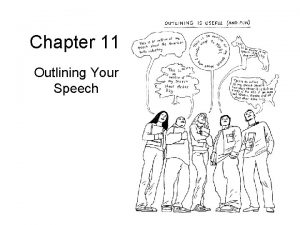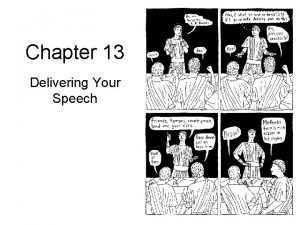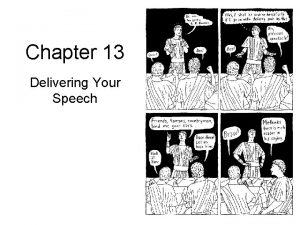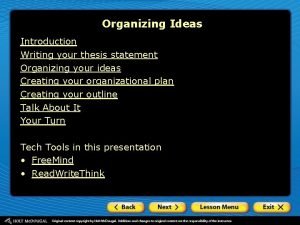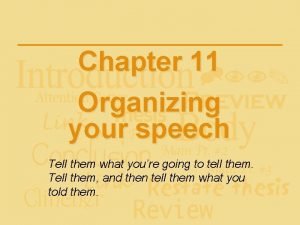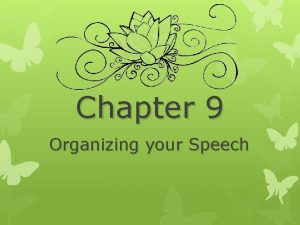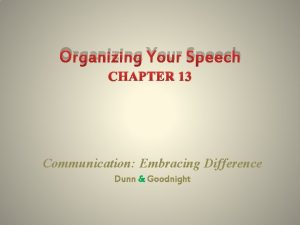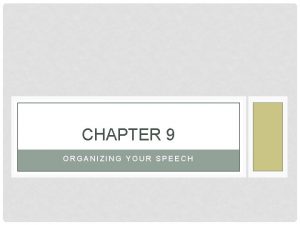Chapter 9 Organizing Your Speech Organizing Your Speech
































- Slides: 32

Chapter 9 Organizing Your Speech

Organizing Your Speech: Introduction • A disorganized speech will confuse your audience. • Clear organization: – Imposes order on your presentation – Helps audience grasp main and supporting points – Is critical in oral communications • Bonus: A clearly structured speech enhances your credibility as a speaker.

Organizing Your Speech: An Overview • Effective organization involves: – Selecting your main points – Organizing your supporting materials – Arranging your main points – Using organizing words and sentences

Selecting Your Main Points • Structure the body of your speech around your main points, the ideas most important for your listeners to remember. • Use supporting points to substantiate main points.

Selecting Your Main Points: Consider Your Purpose • Make sure every main point relates to your presentation’s purpose.

Selecting Your Main Points: Take Your Audience into Account • Identify who your listeners are. • Determine the most interesting and useful information for them.

Selecting Your Main Points: Select an Appropriate Number of Main Points • Limit main points to no more than five, each of which contains only one idea. • Note: Most student speeches have three main points.

Selecting Your Main Points: Select an Appropriate Number of Main Points • Reduce too many main points by: – Looking for relationships between points for potential combinations. – Reviewing audience analysis to see which points you can eliminate. – Evaluating which points are most important to keep • If you only have one main point, consider turning it into your thesis.

Selecting Your Main Points: Select an Appropriate Number of Main Points

Organizing Your Supporting Materials • Explain, prove, and expand on your main points with supporting materials. – Remember these from Chapter 8?

Organizing Your Supporting Materials: Subordination and Coordination • Subordination: Creating a hierarchy of points and supporting materials in your speech – Subpoints develop main point; two per main point – Sub-subpoints support subpoints

Organizing Your Supporting Materials: Subordination Main points are the most important or highest level Supporting materials used to develop main points are subpoints Materials that support subpoints are sub-subpoints

Organizing Your Supporting Materials: Subordination and Coordination • Coordination: Each point at a certain outline level has the same degree of significance. • Each main point is: – Coordinated with the other main points – Coordinated with other subpoints

Subordination and Coordination

Organizing Your Supporting Materials: When a Subpoint Doesn’t Fit • Reword a main point to include the additional information. • Create another main point to include the new material.

Organizing Your Supporting Materials

Tips for Organizing Your Supporting Materials • Tip: Be sure the number of supporting points you have is appropriate for the time limit of the speech. If there are too many, narrow your topic further. • Tip: If you are having difficulty relating all your main points to your specific purpose, look at your thesis again. Maybe it is too broad, too specific, or contains more than one idea.

Arranging Your Main Points • Common methods for speech organization include: – – – – Spatial Temporal (chronological) Causal Comparison Problem-cause-solution Criteria-application Narrative Categorical (topical)

Arranging Your Main Points: Spatial Pattern • Each point can be seen geographically or physically.

Arranging Your Main Points: Temporal Pattern • Each point is in a chronological (time-based) sequence.

Arranging Your Main Points: Causal Pattern • The points reveal a cause-and-effect relationship.

Arranging Your Main Points: Comparison Pattern • The points discuss major similarities and differences between two items.

Arranging Your Main Points: Problem-Cause-Solution Pattern • The points persuade your audience to take action or support a specific policy by: – Arguing that a problem exists – Identifying the causes – Proposing a solution

Arranging Your Main Points: Problem -Cause-Solution Pattern

Arranging Your Main Points: Criteria-Application Pattern • The pattern proposes standards and then applies those standards to your topic.

Arranging Your Main Points: Narrative Pattern • Each point is a story event that uses characters and a plot to convey your message. • The story should support your thesis and demonstrate its validity.

Arranging Your Main Points: Categorical Pattern • Each point represents an important aspect of your topic.

Tips for Arranging Your Main Points • Tip: You should let your specific purpose determine the speech’s organization. For example, if you want to discuss the best coffee chains in your city, you may want to consider a categorical pattern, but if you want to persuade your audience that coffee drinking causes cancer, you may want to use a problem-causesolution pattern. • Tip: If you are having trouble organizing your points, reevaluate your organizational pattern or your specific purpose.

Using Organizing Words and Sentences • To make it easy for your audience to listen to and understand your speech, you should insert organizing words and sentences throughout your speech. • These include: – Transitions – Signposts – Internal previews and internal summaries

Using Organizing Words and Sentences: Transitions • Sentences that link one point in your speech to the next

Using Organizing Words and Sentences: Signposts • Words or phrases in sentences that help audiences understand a speech's structure

Using Organizing Words and Sentences: Internal Previews and Summaries • Internal previews present a short list of the ideas that follow. • Internal summaries review what you just said about the main points.
 Organizing and outlining your speech
Organizing and outlining your speech Organizational method in speech
Organizational method in speech Circular organizational arrangement
Circular organizational arrangement Manuscript for speech
Manuscript for speech Organizing and delivering an entertainment speech
Organizing and delivering an entertainment speech Outlining and organizing the speech contents
Outlining and organizing the speech contents What does a career portfolio look like
What does a career portfolio look like Amtobul example
Amtobul example Organizing an argument
Organizing an argument Organizing your argument
Organizing your argument Chapter 2 worksheet organizing and administering
Chapter 2 worksheet organizing and administering Chapter 17 organizing life's diversity
Chapter 17 organizing life's diversity Give us your hungry your tired your poor
Give us your hungry your tired your poor Planning staffing organizing leading and controlling
Planning staffing organizing leading and controlling Organizing committee structure for an event
Organizing committee structure for an event Strategy implementation organizing for action
Strategy implementation organizing for action Planning directing controlling
Planning directing controlling Marzano element 15
Marzano element 15 Organizing steps
Organizing steps Writing business messages
Writing business messages Organizing an outline
Organizing an outline Chapter 7 organizational structures
Chapter 7 organizational structures Planning organizing directing coordinating controlling
Planning organizing directing coordinating controlling Organizing data in a traditional file environment
Organizing data in a traditional file environment Who are manager
Who are manager Organizing data using frequency distribution
Organizing data using frequency distribution Vocabulary and organizing of text
Vocabulary and organizing of text Core group formation meaning
Core group formation meaning Sequence pattern paragraph
Sequence pattern paragraph The periodic table displays the symbols and
The periodic table displays the symbols and Organizing the business enterprise
Organizing the business enterprise Organizing the periodic table
Organizing the periodic table Organizing principles
Organizing principles
